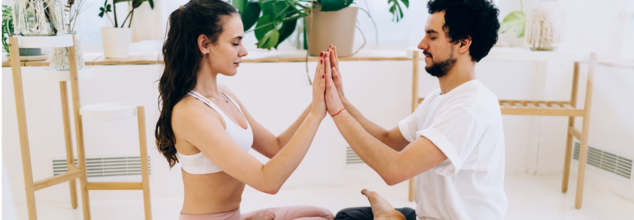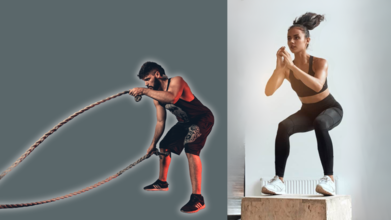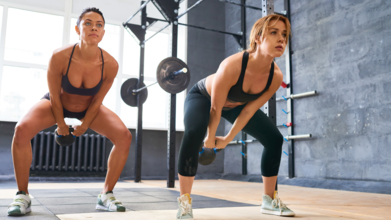- Health Conditions A-Z
- Health & Wellness
- Nutrition
- Fitness
- Health News
- Ayurveda
- Videos
- Medicine A-Z
- Parenting
- Web Stories
Yoga Poses For Two People: Strengthen Bond And Body With 5 Fun And Effective Asanas

Couple yoga (Credit: Canva)
Practicing yoga poses with a partner has been a truly transformative experience for me. Initially, it felt awkward trying to sync our movements, but as we laughed through the stumbles, it brought us closer. One of my favorite poses is the double-tree, where we support each other’s balance, reminding me of how our bond grows stronger when we work together.
The partner camel pose opened up not just my body but my heart, fostering trust and connection. Overall, yoga for two has taught me the importance of patience, trust, and shared growth, both on and off the mat.
Did you know that the word "yoga" means “union” in Sanskrit? This powerful definition reflects not only a connection with oneself but also with others. Practicing yoga with a partner, whether it’s a friend, loved one, or family member, brings an opportunity to strengthen the bond between two individuals.
Couples yoga encourages trust, communication, and laughter, making it a perfect way to connect, relax, and stay healthy together.
Yoga is more than just a physical activity—it’s a way to build a deeper emotional and spiritual connection with your partner. When done together, yoga poses help both individuals work in harmony, balancing each other both physically and emotionally. Plus, you don’t need to be in a romantic relationship to reap the benefits! Best friends, siblings, and even co-workers can enjoy the challenge and fun of these yoga poses.
Here are five yoga poses for two that will deepen your connection, improve flexibility, and add a little lightheartedness to your day.
1. Double-Tree Pose (Beginner Level)
The double-tree pose is a simple yet effective pose that emphasizes balance, trust, and focus. In this pose, each partner stands on one leg, pressing the sole of their foot against the inner thigh or calf of the opposite leg. Partners hold each other’s hands or place palms together in a prayer position. This pose helps improve balance, coordination, and communication between both partners. It’s a great way to kick-start your couples yoga session with stability and laughter.
Benefits
- Improves balance and coordination
- Encourages trust and cooperation
- Enhances core strength
2. Partner Camel Pose (Intermediate Level)
The partner camel pose is a heart-opener that helps build trust and emotional connection. This pose involves kneeling back-to-back with your partner while arching backward, reaching for each other’s hands or shoulders. This movement opens the chest and stretches the entire front body, helping release tension and promote deeper breathing.
Benefits
- Stretches the chest, shoulders, and quadriceps
- Strengthens the back and core muscles
- Opens the heart chakra, fostering a sense of openness and vulnerability
3. Seated Spinal Twist for Two (Beginner Level)
The seated spinal twist is a fantastic stretch for two that releases tension in the lower back and promotes relaxation. In this pose, partners sit back-to-back with legs crossed and gently twist in opposite directions, placing one hand on their partner’s knee and the other on the floor. This twist not only stretches the spine but also promotes a gentle connection between the partners.
Benefits
- Relieves lower back tension and stiffness
- Improves spinal flexibility
- Promotes relaxation and calmness through a gentle twist
4. Two-Person Standing Forward Fold (Beginner Level)
The two-person standing forward fold brings a sense of fun while releasing tight hamstrings and lengthening the spine. In this pose, partners stand facing each other, fold forward, and reach around to clasp their partner’s arms or legs for added support. The forward fold provides a deep stretch for the hamstrings and back muscles, while the connection with your partner creates stability and comfort.
Benefits
- Stretches the hamstrings and spine
- Relieves tension in the neck and back
- Encourages laughter and connection
5. Double Chair Pose (Intermediate to Advanced Level)
Double chair pose is all about teamwork, trust, and communication. In this pose, partners stand back-to-back and squat down as if sitting in an invisible chair. Both partners must work together to maintain balance and stay in sync. This pose strengthens the legs, glutes, and core, while promoting trust and coordination.
Benefits
- Builds leg and glute strength
- Enhances trust and communication
- Improves posture and core stability
Benefits of Performing Couples Yoga
Practicing yoga with a partner requires more than just physical strength; it calls for communication, patience, and trust. The sense of connection that comes from synchronizing your breath and movements deepens emotional bonds and promotes a stronger relationship.
Beyond the emotional connection, yoga offers a multitude of physical health benefits. It improves flexibility, posture, balance, and muscle strength. Couples yoga, in particular, can relieve tension, improve circulation, and boost mental clarity as partners work together.
So, whether you’re looking to have a fun workout with your best friend or deepen your relationship with your significant other, couples yoga is a rewarding way to connect and improve overall well-being. Ready to give it a try? Grab a partner and enjoy the harmony, laughter, and health benefits couples yoga has to offer!
What Happens To Your Body When You Do HIIT Workout Daily?

Credits: Health and me
High-Intensity Interval Training or HIIT has become fitness’s darling for its efficiency: short sessions, intense output, and real results. You burn fat fast, build strength, and maybe even get a runner’s high without logging miles. Still, that thrill can hide a dilemma: doing HIIT every day may do more harm than good. Even as it offers potency, it also pumps up cortisol—the stress hormone—and that’s where things start to tilt.
According to fitness experts, high-intensity workouts trigger cortisol, elevating heart rate, breathing, and blood pressure. That’s fine in controlled bursts—it’s how HIIT pushes your body to adapt. But if your training cadence is relentless and stress from life piles on (say, the pandemic years), your body stays locked in fight-or-flight mode. What feels productive could quietly erode your metabolism, immunity, mood—and long-term health.
HIIT—high-intensity interval training—delivers power-packed bursts of effort, short recovery, and tangible results. You get calories burned, stamina boosted, and even mental focus sharpened in less time than traditional workouts but push too hard, too often, and your body begins to push back. Daily HIIT can shift from performance enhancer to internal stressor, if you're not careful.
Heart
HIIT is exceptional at improving cardiovascular efficiency. Studies consistently show gains in VO₂ max, improved blood vessel flexibility, and better insulin sensitivity—even more so than with steady-state cardio. HIIT reduces resting blood pressure and strengthens the heart’s pump function but when the heart is taxed day after day without rest, it can get overworked—especially if you already have an underlying condition. Overdoing it may result in undue stress on the heart, making symptoms like dizziness or chest tightness warning signs, not badges of dedication.
Metabolism
One of HIIT's biggest draws is the metabolic afterburn—or EPOC: your body brûle calories long after you've wiped the sweat away. It’s efficient, effective, and time-friendly. In studies, HIIT matches or surpasses moderate-intensity exercise in fat loss, waist reduction, and insulin sensitivity.³¹ But metabolic stress isn’t just positive. Without proper recovery, the gains plateau or reverse, especially if cortisol stays elevated.
Hormones and Cortisol
When you push your lungs and heart hard, your body ramps up cortisol—the fight-or-flight hormone. Short-term, that's fine but on a daily back-to-back schedule, cortisol becomes chronic. That’s when fatigue, irritability, sleep disruption, weight gain, and even immune suppression show up. Long-term HIIT without recovery doesn't just train your body—it stresses it.
Immunity Takes a Beating
Moderate exercise can boost your defences but constant high-intensity training changes the game- your immune system flags, white cells dip, and healing slows. In research and fitness communities, daily HIIT is linked to more colds, longer recovery, and increased inflammatory markers. That kind of vulnerability is a clear red flag.
Muscles, Joints and High-Impact Risk
Many HIIT workouts involve jumps, sprints, and explosive movements—all great for power, even better for injury risk. Your knees, ankles, shoulders, and back become targets if fatigue or poor form sets in. Routine high-impact HIIT plus weak stabilizers is a recipe for sprains or tendon issues. Recovery days—and movement diversity—are essential damage control.
Cellular and Mental Benefits
When used wisely, HIIT stimulates mitochondrial growth, boosting your cellular energy power. It sharpens cognitive function, supports mood, and improves overall endurance. But this adaptation happens in the recovery phase—not in the push. Without rest, your cells don’t strengthen—they stall.
Safe Way to Do HIIT Workouts
HIIT is one of the most effective training methods out there—it boosts endurance, burns fat, and saves time. But doing it daily without allowing your body to recover? That’s where it starts to backfire.
Pushing through fatigue may feel like dedication, but overtraining from constant HIIT can leave you sore, exhausted, and more prone to injury. Your muscles, joints, and immune system all need time to bounce back. And if they don’t get it, your performance declines—even if you’re working harder than ever.
Your body doesn’t get stronger during workouts; it gets stronger during rest. Recovery is when your muscles repair, your nervous system resets, and your gains actually lock in.
If you’re serious about results, treat recovery as part of the plan, not an afterthought. Two to three HIIT sessions per week, paired with rest or lower-impact training like strength, walking, or yoga, is more than enough for long-term progress. Listen to your body—fatigue, soreness, and poor sleep are signs you may be overdoing it.
Consistency is key, but so is knowing when to hit pause. That’s the real secret to sustainable strength.
Experts universally recommend 2–3 HIIT sessions per week—no more—with at least 24–48 hours between for recovery. That leaves room for walking, strength, flexibility, or restorative movement while giving your body time to adapt. Smart training means crafting a fitness week, not just firing off daily sprints.
HIIT works when you let it. Daily abuse wears you down. For lasting strength, resilience, and mental clarity, couple your intense interval sessions with recovery, variety, and respect. The gains you get may be invisible by the minute, but over time, they shape a fitter, stronger you.
Trump Orders Return Of School Exercise Challenge After A Decade In US: What Is The Presidential Fitness Test?

Credits: Canva
In a move that has already sparked national debate, President Donald Trump signed an executive order reinstating the once-standard fitness benchmark for American students. The announcement, made alongside professional athletes like golfer Bryson DeChambeau and NFL star Harrison Butker, marks the revival of a decades-old program once intended to promote physical excellence in youth—but which has since drawn criticism for its mental and physical demands.
This return isn’t just about nostalgia. It’s part of a broader initiative that ties into Trump’s sports-focused agenda during his second term and America's preparation to host major sporting events such as the 2025 Ryder Cup, the 2026 FIFA World Cup, and the 2028 Summer Olympics. The rollout of the revived test will be overseen by Health and Human Services Secretary Robert F. Kennedy Jr., who has been vocal about what he calls the “childhood chronic disease crisis.”
The newly revived test is part of the “Make America Healthy Again” agenda championed by Kennedy. His May report emphasizes troubling trends: declining youth activity, climbing obesity rates, and increased incidence of chronic diseases in children. The executive order claims that these trends “weaken our economy, military readiness, academic performance, and national morale.”
Trump’s order reestablishes the President’s Council on Sports, Fitness, and Nutrition, instructing it to develop updated test criteria. It will partner with athletes, sports organizations, and public figures to create what the administration calls a “culture of strength and excellence.”
According to the order, declining fitness among American youth is “a threat to the vitality and longevity of our country,” particularly as the nation approaches its 250th birthday in 2026.
What Was the Presidential Fitness Test?
To understand why this announcement is stirring such heated debate, it's worth revisiting what the test actually involved.
The original Presidential Fitness Test was formalized in 1966 under President Lyndon B. Johnson but was rooted in a much earlier concern about American children's physical fitness. In the 1950s, orthopedic surgeon Hans Kraus and exercise expert Bonnie Prudden found that nearly 60% of American children failed their six-part strength and flexibility test—compared to fewer than 10% of European children. Their findings shocked President Eisenhower and led to the creation of the President’s Council on Youth Fitness.
Over time, the test evolved into a yearly challenge for students aged 6 to 17, usually featuring:
- A one-mile run to measure cardiovascular endurance
- Sit-ups performed within one minute
- Pull-ups or push-ups to test upper body strength
- Sit-and-reach flexibility assessments
- Shuttle run drills to evaluate agility
Students who scored at or above the 85th percentile received the prestigious Presidential Physical Fitness Award. Others received participation certificates.
Why It Was Scrapped in 2012?
Despite its long-standing legacy, the Presidential Fitness Test was phased out during the Obama administration. It was replaced by the Presidential Youth Fitness Program, which emphasized personal health goals over athletic performance. The change was backed by growing concerns around mental health, body image, and the test's "one-size-fits-all" approach.
Educators and health professionals had begun to criticize the test as an outdated model that humiliated students rather than encouraged them. The Centers for Disease Control and Prevention (CDC) reported that even while the test was in place, obesity rates continued to rise—from 13% in 1960 to 34% in 2008—calling into question its effectiveness.
Instead, the new program focused on achievable, individualized goals and health improvements, guided by modern science rather than outdated percentile charts.
Why Bring Presidential Fitness Test Back Now?
So why return to a system that was largely discredited? According to the administration, the decision is tied to more than just fitness—it’s about national identity.
The upcoming 250th anniversary of the United States and its hosting of global sporting events create a symbolic moment to spotlight strength, unity, and youth development. Trump’s team sees physical fitness as an avenue for national pride and global competitiveness, especially as statistics continue to show American youth falling behind in basic health markers.
Secretary Kennedy has also argued that the current generation is experiencing an unprecedented rise in chronic disease, inactivity, and poor dietary habits—problems he believes need stronger interventions than what current programs provide.
Although the exact criteria for the new test haven’t been released, the White House says it will retain some traditional components while modernizing the structure. DeChambeau, now chairing the President’s Council on Sports, Fitness, and Nutrition, has hinted that flexibility, endurance, and strength will remain central to the updated test.
Implementation may begin as early as the next academic year, although many details—such as whether participation will be mandatory, how the test will account for students with disabilities, and what changes might be made to avoid previous mental health criticisms—remain unclear.
Is This A Fitness Test or a Cultural Flashpoint?
For many, this isn’t just a test—it’s a reflection of deeper cultural tensions. Supporters argue the return of the Presidential Fitness Test is a much-needed wake-up call for a generation growing increasingly sedentary and disconnected from physical activity. Critics, however, see it as a regressive move that prioritizes performance over wellbeing.
Organizations like the American Academy of Pediatrics and National Association for Sport and Physical Education have yet to weigh in formally, but past criticism suggests skepticism. Questions remain about the scientific basis of the test, its potential mental health effects, and whether it will be implemented fairly across diverse school populations.
Bringing back the Presidential Fitness Test might appeal to those nostalgic for dodgeball days and presidential awards, but it also reopens debates that never really went away. At its best, the test was a motivator and a symbol of excellence. At its worst, it was a public performance of failure for students who didn’t fit the mold.
The Viral '100 Swings A Day' Kettlebell Craze Could Backfire, Try This Smarter Workout Plan Instead

Credits: Canva
It starts off sounding like a no-brainer: do 100 kettlebell swings every day, torch calories, strengthen your glutes and back, and feel fitter—all without needing a gym. That’s the promise behind the latest viral fitness trend sweeping through TikTok and Instagram: the “100 Kettlebell Swings a Day” challenge.
On the surface, it’s appealing. It’s simple, requires minimal equipment, and promises fast results. But dig deeper, and the story becomes more complicated—and potentially risky. While kettlebell swings can absolutely be part of a strong fitness program, experts are urging caution.
The kettlebell swing is an explosive, full-body movement that targets your posterior chain—your glutes, hamstrings, and lower back—while also getting your heart rate up. It’s efficient and empowering.
When condensed into a daily 100-rep routine, the idea is that a quick burst of intensity, repeated consistently, will drive fat loss, build muscle, and increase endurance. And to be fair, some people might see short-term benefits—particularly those new to movement or coming off a sedentary routine but that’s where the benefits often end.
The biggest red flag with this challenge is that it doesn’t account for your body. A 20-year-old athlete and a 50-year-old beginner with lower back stiffness should not be doing the same kettlebell routine.
These swings demand coordination, mobility, core control, and hip hinge mechanics. If you’re not confident with your form—or you’re compensating with your back instead of your hips—you’re reinforcing poor mechanics and inviting injury.
Effective training needs context. Your goals, your movement capacity, and your history all matter.
Why No Progression Means No Progress?
Your body adapts fast. Do the same 100 swings, with the same weight, every day—and eventually, you’ll plateau. That soreness you felt in week one? It’ll vanish by week three. So will most of the benefits.
Fitness programming relies on the principle of progressive overload—gradually increasing the challenge to stimulate new adaptation. That could mean heavier weights, more reps, or more complex movements. The 100-swing challenge skips this entirely. That makes it more of a gimmick than a growth strategy.
Daily kettlebell swings, especially performed explosively, place a load on your central nervous system and muscular system. And without adequate recovery? You’re flirting with fatigue, chronic soreness, and potential injury.
Muscle strains, joint pain, nagging shoulder or back injuries—these are common outcomes of repetitive movement without sufficient rest or technique support. Overuse injuries can take months to recover from, pulling you entirely out of your fitness routine.
In short, just because you can do something daily doesn’t mean you should.
Fitness isn’t just about movement quantity. It’s also about movement quality and variety. Real strength and mobility come from using your body in multiple planes—pulling, pushing, squatting, rotating, and stabilizing.
A daily dose of 100 swings is incredibly narrow. You’re training one movement pattern, over and over. That’s better than doing nothing, sure—but it’s far from comprehensive, and it can become boring or even mindless over time.
You want to build a resilient, capable body—not just tick off another daily rep count.
How to Use Kettlebells The Smart Way?
Kettlebell swings are still an excellent tool when used strategically. If you like the movement, here’s how to make it part of a smarter, more sustainable plan:
Start with Form: Get a qualified coach or trainer to check your swing. Form trumps everything.
Use the Right Weight: Too light, and you’re not challenged. Too heavy, and you risk injury.
Add Variety: Mix swings with other movements like squats, presses, lunges, or rows. Build circuits that target multiple muscle groups.
Rest Matters: Give your body time to recover. That’s where strength is built.
Progress Over Time: Increase reps, weight, or intensity gradually.
Instead of 100 swings a day, try a kettlebell workout 3–4 times per week with varied reps and rest days built in. It’s safer, smarter, and more effective.
The appeal of a 100-swing challenge is understandable. It gives structure. It’s accessible. It promises results. But results come from strategy, not repetition for repetition’s sake.
The reality is, your body needs progression. It needs adaptation. It needs rest. And above all, it needs you to pay attention to how it feels, not how many reps you’ve logged.
If you’re just starting out, look for a program—or a professional—that meets you where you are and evolves as you do. Fitness is a journey, not a one-size-fits-all challenge.
The kettlebell swing is a powerful, dynamic move when done right. But turning it into a daily 100-rep ritual without context, progression, or recovery? That’s not training—that’s repetition.
The goal should always be sustainable strength and long-term health, not chasing short-term trends. So skip the viral challenge—and swing smarter instead.
© 2024 Bennett, Coleman & Company Limited

